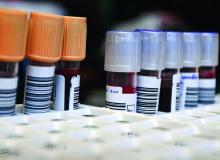A blood test has been found to be effective for detecting early pancreatic cancer in those at high risk, with the potential to find the deadly cancer at a time when it is more likely to be treatable with surgery, according to phase 2b findings recently published in Science Translational Medicine.
In a 337-person study, researchers found that a blood panel for the protein thrombospondin-2 (THBS2) and cancer antigen 19-9 (CA19-9), measured with a standard ELISA test, together detected pancreatic ductal adenocarcinoma (PDAC) with a specificity of 98% and a sensitivity of 87%. The test was effective at distinguishing patients with PDAC from controls and those with benign pancreatic disease across all stages of the cancer, wrote Kenneth Zaret, PhD, at the University of Pennsylvania, Philadelphia.
There is a profound need for better early detection of PDAC, which is often only discovered in its advanced stages when it is essentially untreatable, leading to an overall 5-year survival rate of just 7%.CA19-9 is already a known marker for PDAC, but it is a deeply flawed one because it is also elevated in people with nonmalignant pancreatic conditions and can produce false negatives in people without certain antibodies.
But, together, researchers found, THBS2 and CA19-9 make a good pairing for early detection. In the paper, researchers described cases of patients who had no CA19-9 signal at all, likely because they were Lewis-antigen negative, but who had high THBS2 levels. There were also several cases in which THBS2 levels overlapped with the upper end of the normal range but with elevated CA19-9 levels.
“Thus, the two markers appeared to be complementary in their ability to detect PDAC,” Dr. Zaret wrote.
Researchers were able to test for markers by reprogramming advanced PDAC cells to induce a pluripotent stem cell–like state.
Because of the low prevalence of PDAC in the general population, researchers are not recommending the panel as a general screening test.
“We suggest that the THBS2/CA19-9 marker panel could serve as a low-cost, nonintervention screening tool in asymptomatic individuals who have a high risk of developing PDAC,” Dr. Zaret wrote, “and also in patients who are newly diagnosed with diabetes mellitus that developed as a result of pancreatic injury – but not in the general population.”


